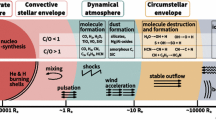Abstract
The results of an analysis of observations of the cool (M8) dwarf TRAPPIST-1 obtained on the Kepler Space Telescope (the K2 continuation mission) are presented. TRAPPIST-1 possesses a planetary system containing at least seven planets. In all, the observations consist of 105 584 individual brightness measurements made over a total duration of 79 days. Brightness power spectra computed for TRAPPIST-1 exhibit a peak corresponding to P0 = 3.296 ± 0.007d. There are also two peaks with lower significances at P1 = 2.908d and P2 = 2.869d, which cannot be explained by the presence of differential rotation. The observational material available for TRAPPIST-1 is subdivided into 21 datasets, each covering one stellar rotation period. Each of the individual light curves was used to construct a map of the star’s temperature inhomogeneities. On average, the total spotted area of TRAPPIST-1 was S = 5% of the entire visible area. The difference between the angular rotation rates at the equator and at the pole is estimated to be ΔΩ = 0.006. The new results obtained together with data from the literature are used to investigate the properties of this unique star and compare them to the properties of other cool dwarfs. Special attention is paid to the star’s evolutionary status (its age). All age estimates for TRAPPIST-1 based on its activity characteristics (rotation, spot coverage, UV and X-ray flux, etc.) indicate that the star is young.
Similar content being viewed by others
References
M. Gillon, E. Jehin, S. M. Lederer, L. Delrez, et al., Nature (London, U.K.) 533, 221 (2016).
M. Gillon, A. H. M. J. Triaud, B.-O. Demory, E. Jehin, et al., Nature (London, U.K.) 542, 456 (2017).
R. Luger, M. Sestovic, E. Kruse, S. L. Grimm, et al., Nat. Astron. 1, 0129 (2017).
A. J. Burgasser and E. E. Mamajek, Astrophys. J. 845, 110 (2017).
C. X. Huang, K. Penev, J. D. Hartman, G. Á. Bakos, W. Bhatti, I. Domsa, and M. de Val-Borro, Mon. Not. R. Astron. Soc. 454, 4159 (2015).
I. S. Savanov and E. S. Dmitrienko, Astron. Rep. 55, 890 (2011).
I. S. Savanov and E. S. Dmitrienko, Astron. Rep. 56, 116 (2012).
K. Vida, Z. Kövári, A. Pál, K. Oláh, and L. Kriskovics, Astrophys. J. 841, 124 (2017).
I. S. Savanov, Astrophys. Bull. 70, 292 (2015).
I. S. Savanov, N. G. Gladilina and E. S. Dmitrienko, Astron. Rep. 60, 1006 (2016).
I. S. Savanov and K. G. Strassmeier, Astron. Nachr. 329, 364 (2008).
I. S. Savanov, Astron. Rep. 55, 341 (2011).
S. P. Jäervinen, H. Korhonen, S. V. Berdyugina, I. Ilyn, K. G. Strassmeier, M. Weber, I. Savanov, and I. Tuominen, Astron. Astrophys. 488, 1047 (2008).
I. S. Savanov, Astron. Rep. 54, 1125 (2010).
J. R. Barnes, A. Colier Cameron, J.-F. Donati, D. J. James, S. C. Marsden and P. Petit, Mon. Not. R. Astron. Soc. 357, L1 (2005).
E. S. Dmitrienko and I. S. Savanov, Astron. Rep. 61, 871 (2017).
E. S. Dmitrienko and I. S. Savanov, Astron. Rep. 61, 122 (2017).
I. S. Savanov and E. S. Dmitrienko, Astron. Rep. 57, 657 (2013).
A. McQuillan, S. Aigrain, and T. Mazeh, Mon. Not. R. Astron. Soc. 432, 1203 (2013).
T. Reinhold and L. Gison, Astron. Astrophys. 583, A65 (2015).
I. S. Savanov, S. A. Naroenkov, M. A. Nalivkin, et al., Astrophys. Bull. (2018, in press).
I. S. Savanov and E. S. Dmitrienko, Astron. Rep. 61, 996 (2017).
P. J. Wheatley, T. Louden, V. Bourrier, D. Ehrenreich, and M. Gillon, Mon. Not. R. Astron. Soc. 465, L74 (2017).
V. Bourrier, D. Ehrenreich and P. J. Wheatley, Astron. Astrophys. 599, L3 (2017).
D. Fabbian, R. Simoniello, R. Collet, S. Criscuoli, et al., Astron. Nachr. 338, 753 (2017).
Author information
Authors and Affiliations
Corresponding author
Additional information
Original Russian Text © E.S. Dmitrienko, I.S. Savanov, 2018, published in Astronomicheskii Zhurnal, 2018, Vol. 95, No. 6, pp. 438–446.
Rights and permissions
About this article
Cite this article
Dmitrienko, E.S., Savanov, I.S. Activity of the M8 Dwarf TRAPPIST-1. Astron. Rep. 62, 412–419 (2018). https://doi.org/10.1134/S1063772918060033
Received:
Accepted:
Published:
Issue Date:
DOI: https://doi.org/10.1134/S1063772918060033




